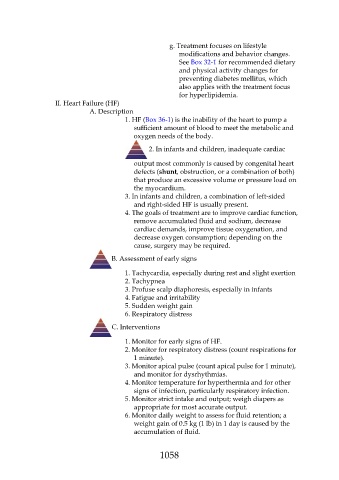Page 1058 - Saunders Comprehensive Review For NCLEX-RN
P. 1058
g. Treatment focuses on lifestyle
modifications and behavior changes.
See Box 32-1 for recommended dietary
and physical activity changes for
preventing diabetes mellitus, which
also applies with the treatment focus
for hyperlipidemia.
II. Heart Failure (HF)
A. Description
1. HF (Box 36-1) is the inability of the heart to pump a
sufficient amount of blood to meet the metabolic and
oxygen needs of the body.
2. In infants and children, inadequate cardiac
output most commonly is caused by congenital heart
defects (shunt, obstruction, or a combination of both)
that produce an excessive volume or pressure load on
the myocardium.
3. In infants and children, a combination of left-sided
and right-sided HF is usually present.
4. The goals of treatment are to improve cardiac function,
remove accumulated fluid and sodium, decrease
cardiac demands, improve tissue oxygenation, and
decrease oxygen consumption; depending on the
cause, surgery may be required.
B. Assessment of early signs
1. Tachycardia, especially during rest and slight exertion
2. Tachypnea
3. Profuse scalp diaphoresis, especially in infants
4. Fatigue and irritability
5. Sudden weight gain
6. Respiratory distress
C. Interventions
1. Monitor for early signs of HF.
2. Monitor for respiratory distress (count respirations for
1 minute).
3. Monitor apical pulse (count apical pulse for 1 minute),
and monitor for dysrhythmias.
4. Monitor temperature for hyperthermia and for other
signs of infection, particularly respiratory infection.
5. Monitor strict intake and output; weigh diapers as
appropriate for most accurate output.
6. Monitor daily weight to assess for fluid retention; a
weight gain of 0.5 kg (1 lb) in 1 day is caused by the
accumulation of fluid.
1058

